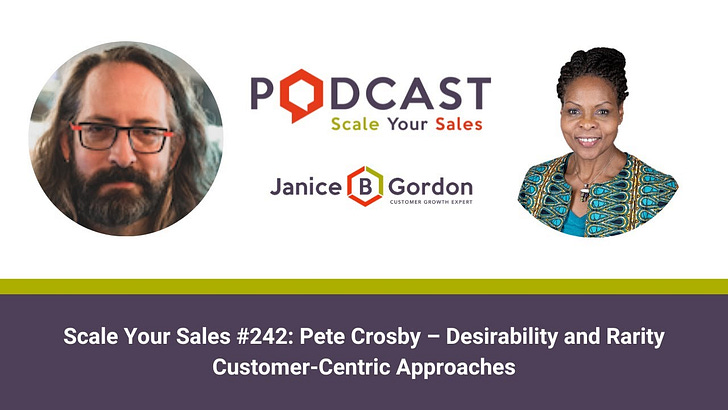The Four Pillars of a Whole Revenue Strategy - a guide for CEOs.
Revenue & Sales are not the same thing
Revenue growth isn’t about selling—it’s about aligning every part of your go-to-market strategy with a clear, scalable framework.
On a recent episode of Janice B. Gordon’s Scale Your Sales podcast, I shared my approach that more than 100 SaaS businesses have deployed to break through growth plateaus and scale successfully.
You can watch the whole episode here:
In the meantime, here’s the TL;Didn’t Watch:
The Four Pillars.
1. Desirability
Is Your Product Truly Needed?
The foundation of any strong Revenue Strategy is desirability—creating a product that solves an urgent problem. Taking this a step further, the twin importance of Criticality (how essential the solution is) and Rarity (how unique the solution is) are essential. If your product sits at the intersection of high Criticality and high Rarity, you have a winning proposition.
However, many SaaS businesses mistake a useful product for a must-have one. The key question to ask is: Would your buyer’s business get critical events wrong without you? If the answer isn’t a strong yes, it may be time to revisit your product-market fit.
2. Clarity
Can You Tell a Story That Sells?
Having a desirable product isn’t enough if your messaging isn’t clear. Too often, SaaS companies struggle to explain their value proposition in a way that resonates with buyers. Clarity means distilling complex technical capabilities into a compelling, easy-to-understand narrative.
A great example is Uber. Before Uber, getting a late-night ride was a hassle, but few people actively thought about this problem. Uber’s success wasn’t just about building an app—it was about communicating a simple, clear message: "Tap a button, get a ride." Your business needs the same level of clarity in its positioning.
3. Predictability
Can You Scale Your Revenue Model?
One of the biggest roadblocks to scaling revenue is inconsistency. SaaS businesses often grow by relying on a few rockstar salespeople or aggressive marketing pushes, but they fail to build a repeatable system.
Predictability in revenue generation means building a scalable model where growth isn’t dependent on one or two key individuals. This requires:
A defined buying process that your team can follow successfully.
Marketing strategies that generate leads consistently, not sporadically.
A structured onboarding and retention plan that ensures customers see ongoing value.
If you find yourself constantly “hustling” for the next big deal, it’s a sign that your revenue model lacks predictability.
4. Deliverability
Do Customers See and Share the Value?
Deliverability is the final pillar — ensuring customers not only receive what was promised but also recognize its value. SaaS businesses often focus too much on acquisition and not enough on value realization for the customer.
This is where many companies miss the mark. A customer might buy your product, but if they don’t actively use it and see results, they won’t renew or refer others. The best measure of success is when customers:
Expand their usage over time.
Advocate for your product within their networks.
Provide testimonials and case studies that fuel future sales.
This creates a feedback loop—when customers see value, they reinforce desirability, driving further growth.
Janice asked me what can go wrong & here’s the number one reason:
Siloed Leadership.
Breaking Down Silos for a Unified Revenue Strategy.
One of the biggest mistakes SaaS companies make is treating marketing, sales, and product as separate entities. In the podcast I stress the importance of a unified revenue strategy that aligns all teams under a single goal.
Marketing isn’t just about lead generation—it should ensure the right narrative is reaching the right audience. Sales isn’t just about closing deals—it should validate and reinforce the clarity of messaging. Product development shouldn’t operate in isolation—it should prioritize enhancements that drive greater desirability and deliverability.
Instead of working in silos, companies should create cross-functional leadership teams where marketers, salespeople, CS execs and product leaders work together to address these four pillars. The result? A company that moves in sync towards sustainable, scalable growth.
The Takeaway for SaaS CEOs.
We call this Whole Revenue Strategy.
The issue is rarely “a sales problem” but a deeper misalignment in your Revenue Strategy. By focusing on desirability, clarity, predictability, and deliverability, you create a business that doesn’t just sell—it grows sustainably.
Before you invest in more sales hires or marketing campaigns, take a step back and ask yourself:
Is our product solving an urgent problem that customers truly care about?
Can we explain our value proposition in a clear and compelling way?
Do we have a repeatable, scalable sales and marketing engine?
Are customers realizing value and advocating for our product?
By addressing these questions, you can shift from short-term growth tactics to a long-term revenue strategy that sets you up for sustained success.
Whole Revenue Summit.
You can hear more about this approach from me, living legend & Crossing the Chasm author, Geoffrey Moore, and a host of other experts at the Whole Revenue Summit in June. More details here.
Feel free to email us at enquire@revelesco.com at any point.
Pete & the Revelesco team.





Spot on